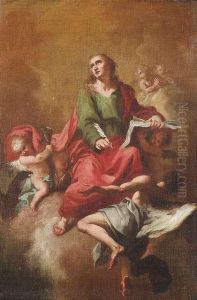Josef Hauber Paintings
Josef Hauber was a German painter and lithographer born on October 5, 1787, in Stuttgart, Germany. He was known for his work during the Biedermeier period, a term that refers to an era in Central Europe between 1815 and 1848, which is characterized by a sense of security and middle-class comfort, following the upheaval of the Napoleonic Wars.
Hauber's artistic education began at the Hohe Karlsschule Stuttgart, a prestigious military academy that also offered training in the arts. Although the academy was primarily focused on military and administrative careers, it provided a rigorous environment for studying various disciplines, including art. After his studies, he worked primarily in Stuttgart and became known for his portraits and genre scenes, which often depicted the contentedness of domestic life typical of the Biedermeier aesthetic.
During his career, Hauber also developed an interest in lithography, a then relatively new printmaking process that allowed for the mass production of images. This technology was crucial in disseminating visual culture at the time and played a significant role in the popularization of art among the middle classes. Hauber's lithographs, like his paintings, conveyed a sense of tranquility and order that resonated with contemporary tastes.
Despite his contributions to the art of his time, Josef Hauber did not gain the same level of fame as some of his contemporaries. His works, however, remain as historical documents that offer insight into the social and cultural milieu of 19th-century Germany. They reflect the values and aesthetics of the Biedermeier period, a time that cherished simplicity, modesty, and the pleasures of home and family.
Josef Hauber continued to work and live in Stuttgart throughout his life. He passed away on May 12, 1865. Today, his works can be found in various art collections and museums, and they continue to be studied for their contribution to the understanding of the Biedermeier period in German art history.
